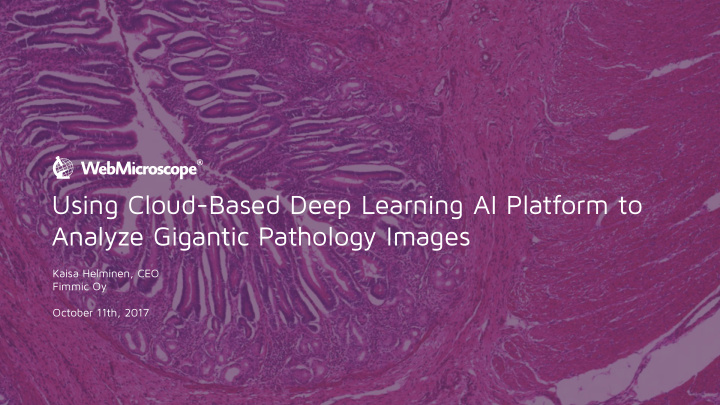



Using Cloud-Based Deep Learning AI Platform to Analyze Gigantic Pathology Images Kaisa Helminen, CEO Fimmic Oy October 11th, 2017
Cancer Every third person affected 14 Million new patients in 2012 +50% more by 2030 Increasing number of samples
Problem Increasing number of samples Gap! Lack of pathologists
Microscopy in tissues diagnostics Subjective analysis Manual visual methods Risk for variability in diagnosis
Digitalization -> Deep Learning AI
Digitalization enables Easy sample archiving and retrieval Sharing, remote consultation Machine vision & Deep Learning AI -assisted analysis, e.g. % of tumor tissue, tumor grading, identification of infection, quantification of certain features, etc.
How to create a virtual slide? Images captured at high magnification Up to 100 000 image tiles Stitched digitally and compressed to a large picture montage (Gb - Tb)
Artificial WebMicroscope Intelligence Workflow Any microscope Pathologists Researchers Educators Samples Any device scanner
Artificial Intelligence & Deep Learning Facial recognition Self-driving cars Tissue diagnostics id-labs.org The Guardian
Different types of Deep Learning Image Analysis tasks 1. Laborious quantification tasks, combined with region of interest selection, e.g. quantification of certain cells in epithelium 2. Segmentation of tissue based on morphology, e.g. tumor grading, epithelium/stroma segmentation 3. Detecting and quantifying rare targets, e.g. infectious agents, forensic samples
Training of deep learning classifiers Whole slide Training set from sample Application to Deep Learning 1 2 3 4 samples regions new samples Epithelium Original Labelled Epithelium segmentation from breast cancer samples.
Application example 1 - Quantification task Breast cancer diagnostics, Quantification of Ki67+ cells from epithelium
1. Epithelium-stroma 2. Quantification of Ki67 + and - segmentation cells inside the epithelium
Negative and weak signals Moderate and Strong
Context-intelligent Image Analysis Enables full automation Removes extra staining step -> Saves time Accurate Reproducible -> Supports correct diagnosis
Application example 2 - Automated segmentation of tumor area Prostate cancer, Segmentation of cancer tissue, area quantification H&E stained prostate tissue Result image - segmentation
Application example 3 - Quantification task Testicular Cancer, Quantification of tumor infiltrating lymphocytes (TIL%) Heat map showing immune cell detec7on H&E of immune cell rich region FIMM – Oxford collabora0on 2017, unpublished results
Application example 3 - Quantification task Testicular Cancer, Quantification of tumor infiltrating lymphocytes (TIL%) Digitized whole slide images of testicular cancer are huge gigabyte-sized files Areas of infiltrating immune cells detected by automated analysis includes millions of immune cells (red areas) FIMM – Oxford collabora0on 2017, unpublished results
Example patient: Immune cells in testicular cancer Automated counting result Total immune cell count = 768.349 Immune cells/square mm tumor = 4223 Details of the analysis shown in the video FIMM – Oxford collabora0on 2017, unpublished results
Application example 4 - Quantification Task Quantification of fat accumulation in liver cells Consistent Accuracy and Reproducibility over large sample sets
Application example 5 - Quantification from segmented area Quantification of fibrosis in liver tissue Significant time savings Reproducibility
Application example 6 - Quantification Task, complex background Quantification of nerve cell bodies from rat brain tissue (Parkinson’s, Alzheimer’s) Significant time savings: From 45 minutes to 0,5 minutes analysis Unforeseen Accuracy & Reproducibility
Application example 7 - Quantification from selected tissue compartments Quantification of glucagon+ alpha cells from Islets of Langerhans in pancreas Significant time savings Reproducibility
Application example 8 - Identification of rare targets Detection of Malaria infection in red blood cells
Examples of performed Deep Learning Image Analysis Applications Breast cancer biomarkers: ER, PR, Ki67 + Epithelium/stroma segmentation Breast cancer, mitosis quantification Prostate cancer: Gland and epithelium segmentation Lung cancer, mouse tissue: Tumor burden, tumor classification Colon cancer, Ulcerative Cholitis Seminoma (testicular cancer): TIL% Liver biopsies: Hepatosteatosis, fibrosis Rat brain: Nerve cell bodies (Parkinsons, ALS research) Forensic pathology: sperm detection from smears Blood: RBC, WBC, Platelets, Malaria parasites etc. All algorithms are intended for Research Use Only.
Immunofluorescence Images
WebMicroscope - Intelligent Image Analysis in Cloud Advanced Image Storage and Deep Learning Algorithms & Disruptive business model Collaboration tools in Cloud Cloud computing Affordable SaaS model for all Compatibility sizes of projects No local hardware Efficient compression Indefinite possibilities for algorithms
The Future of Pathology is Digital Supportive data for decision making -> Prognosis -> Suggesting treatment -> Faster, more accurate diagnosis and cure
Experienced Core Team Combination of life science entrepreneurs, software development and machine vision experts & recognized scientists. Kaisa Helminen Johan Lundin MD, Mikael Lundin MD, Kari Pitkänen Antti Merivirta Tuomas Ropponen Mikael Jääskeläinen CEO CSO Director of Concept Business Development Marketing Manager CTO Sales Manager Co-Founder Design Co-Founder Board Member Co-Founder Board Member Previously: Board Member FIMM Sartorius FIMM Outotec Sartorius FIMM 360Visualizer Fisher Scientific Thermo Scientific Karolinska Institute Biohit Fisher Scientific University of Helsinki Testure Finland Finnzymes, co- Finnzymes HUS Delta-Enterprise Finnzymes founder, sold to Thermo Fisher Scientific in 2010
Contact Kaisa Helminen, CEO +358 40 679 0669 kaisa.helminen@fimmic.com www.webmicroscope.com @kaisa_helminen
Recommend
More recommend